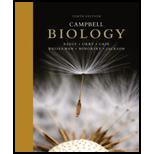
Campbell Biology (10th Edition)
10th Edition
ISBN: 9780321775658
Author: Jane B. Reece, Lisa A. Urry, Michael L. Cain, Steven A. Wasserman, Peter V. Minorsky, Robert B. Jackson
Publisher: PEARSON
expand_more
expand_more
format_list_bulleted
Textbook Question
Chapter 39, Problem 10TYU
SCIENTIFIC INQUIRY A plant biologist observed a peculiar pattern when a tropical shrub was attacked by caterpillars. After a caterpillar ate a leaf, it would skip over nearby leaves and attack a leaf some distance away. Simply removing a leaf did not deter caterpillars from eating nearby leaves. The biologist suspected that an insect-damaged leaf sent out a chemical that signaled nearby leaves. How could the researcher test this hypothesis?
Expert Solution & Answer
Want to see the full answer?
Check out a sample textbook solution
Students have asked these similar questions
Not part of a graded assignment, from a past midterm
Not part of a graded assignment, from a past midterm
Please answer question! Not a graded assignment, just a past midterm question
Chapter 39 Solutions
Campbell Biology (10th Edition)
Ch. 39.1 - What are the morphological differences between...Ch. 39.1 - Cycloheximide is a drug that inhibits protein...Ch. 39.1 - Prob. 3CCCh. 39.2 - Prob. 1CCCh. 39.2 - WHAT IF? If a plant has the double mutation err...Ch. 39.2 - Prob. 3CCCh. 39.3 - If an enzyme in field-grown soybean leaves is most...Ch. 39.3 - WHAT IF? If a plant flowers in a controlled...Ch. 39.3 - MAKE CONNECTIONS Plants detect the quality of...Ch. 39.4 - Prob. 1CC
Ch. 39.4 - Prob. 2CCCh. 39.4 - Prob. 3CCCh. 39.5 - What are some drawbacks of spraying fields with...Ch. 39.5 - Chewing insects mechanically damage plants and...Ch. 39.5 - Many fungal pathogens get food by causing plant...Ch. 39.5 - WHAT IF? Suppose a scientist finds that a...Ch. 39 - What are two common ways by which signal...Ch. 39 - Is there any truth to the old adage, "One bad...Ch. 39 - Why did plant physiologists propose the existence...Ch. 39 - Plants that have acclimated to drought stress are...Ch. 39 - Prob. 39.5CRCh. 39 - Prob. 1TYUCh. 39 - Prob. 2TYUCh. 39 - Prob. 3TYUCh. 39 - How may a plant respond to severe heat stress? (A)...Ch. 39 - Level 2: Application/Analysis 5. The signaling...Ch. 39 - If a long-day plant has a critical night length of...Ch. 39 - Prob. 7TYUCh. 39 - DRAW IT Indicate the response to each condition by...Ch. 39 - Level 3: Synthesis/Evaluation 9. EVOLUTION...Ch. 39 - SCIENTIFIC INQUIRY A plant biologist observed a...Ch. 39 - SCIENCE. TECHNOLOGY, AND SOCIETY Describe how our...Ch. 39 - Prob. 12TYUCh. 39 - Prob. 13TYU
Knowledge Booster
Learn more about
Need a deep-dive on the concept behind this application? Look no further. Learn more about this topic, biology and related others by exploring similar questions and additional content below.Similar questions
- What does the heavy dark line along collecting duct tell us about water reabsorption in this individual at this time? What does the heavy dark line along collecting duct tell us about ADH secretion in this individual at this time?arrow_forwardBiology grade 10 study guidearrow_forwardI would like to see a professional answer to this so I can compare it with my own and identify any points I may have missedarrow_forward
- what key characteristics would you look for when identifying microbes?arrow_forwardIf you had an unknown microbe, what steps would you take to determine what type of microbe (e.g., fungi, bacteria, virus) it is? Are there particular characteristics you would search for? Explain.arrow_forwardavorite Contact avorite Contact favorite Contact ୫ Recant Contacts Keypad Messages Pairing ง 107.5 NE Controls Media Apps Radio Nav Phone SCREEN OFF Safari File Edit View History Bookmarks Window Help newconnect.mheducation.com M Sign in... S The Im... QFri May 9 9:23 PM w The Im... My first.... Topic: Mi Kimberl M Yeast F Connection lost! You are not connected to internet Sigh in... Sign in... The Im... S Workin... The Im. INTRODUCTION LABORATORY SIMULATION Tube 1 Fructose) esc - X Tube 2 (Glucose) Tube 3 (Sucrose) Tube 4 (Starch) Tube 5 (Water) CO₂ Bubble Height (mm) How to Measure 92 3 5 6 METHODS RESET #3 W E 80 A S D 9 02 1 2 3 5 2 MY NOTES LAB DATA SHOW LABELS % 5 T M dtv 96 J: ப 27 כ 00 alt A DII FB G H J K PHASE 4: Measure gas bubble Complete the following steps: Select ruler and place next to tube 1. Measure starting height of gas bubble in respirometer 1. Record in Lab Data Repeat measurement for tubes 2-5 by selecting ruler and move next to each tube. Record each in Lab Data…arrow_forward
arrow_back_ios
SEE MORE QUESTIONS
arrow_forward_ios
Recommended textbooks for you
 Biology (MindTap Course List)BiologyISBN:9781337392938Author:Eldra Solomon, Charles Martin, Diana W. Martin, Linda R. BergPublisher:Cengage Learning
Biology (MindTap Course List)BiologyISBN:9781337392938Author:Eldra Solomon, Charles Martin, Diana W. Martin, Linda R. BergPublisher:Cengage Learning Concepts of BiologyBiologyISBN:9781938168116Author:Samantha Fowler, Rebecca Roush, James WisePublisher:OpenStax College
Concepts of BiologyBiologyISBN:9781938168116Author:Samantha Fowler, Rebecca Roush, James WisePublisher:OpenStax College
 Biology Today and Tomorrow without Physiology (Mi...BiologyISBN:9781305117396Author:Cecie Starr, Christine Evers, Lisa StarrPublisher:Cengage Learning
Biology Today and Tomorrow without Physiology (Mi...BiologyISBN:9781305117396Author:Cecie Starr, Christine Evers, Lisa StarrPublisher:Cengage Learning Biology 2eBiologyISBN:9781947172517Author:Matthew Douglas, Jung Choi, Mary Ann ClarkPublisher:OpenStax
Biology 2eBiologyISBN:9781947172517Author:Matthew Douglas, Jung Choi, Mary Ann ClarkPublisher:OpenStax

Biology (MindTap Course List)
Biology
ISBN:9781337392938
Author:Eldra Solomon, Charles Martin, Diana W. Martin, Linda R. Berg
Publisher:Cengage Learning

Concepts of Biology
Biology
ISBN:9781938168116
Author:Samantha Fowler, Rebecca Roush, James Wise
Publisher:OpenStax College



Biology Today and Tomorrow without Physiology (Mi...
Biology
ISBN:9781305117396
Author:Cecie Starr, Christine Evers, Lisa Starr
Publisher:Cengage Learning

Biology 2e
Biology
ISBN:9781947172517
Author:Matthew Douglas, Jung Choi, Mary Ann Clark
Publisher:OpenStax
How do Plants Handle Stress?; Author: Alex Dainis;https://www.youtube.com/watch?v=TYsnveEHqec;License: Standard Youtube License